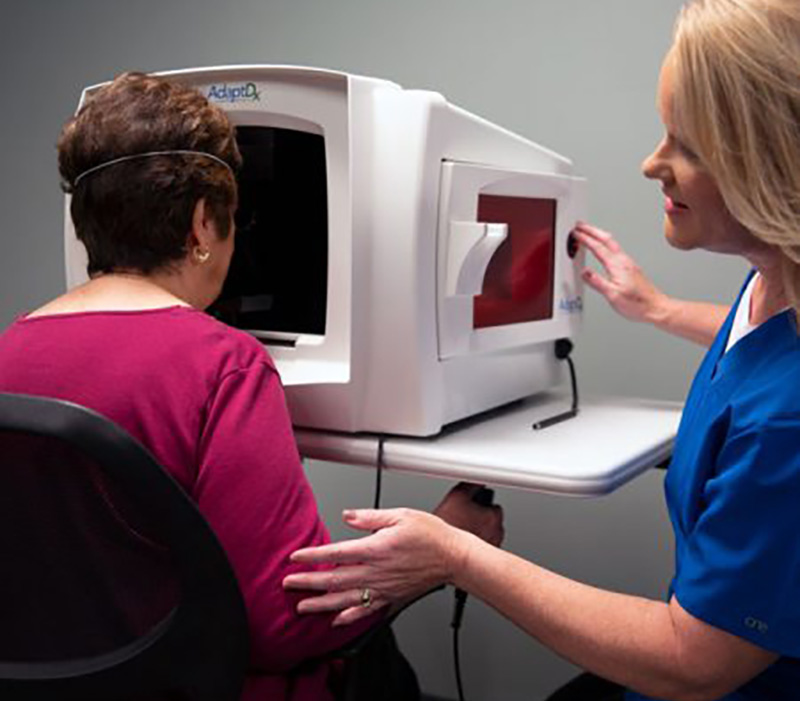Macular Degeneration

The doctors at Nova Vision Center have the expertise and the latest in technology to diagnose macular degeneration in its earliest stages before you may be aware of symptoms or loss of vision. While there is currently no cure for macular degeneration, the earlier in the development of the disease you get diagnosed, the more proactive measures you can take to delay or even prevent blindness.
What is Macular Degeneration?
Age-related macular degeneration (AMD) is a chronic, progressive disease that affects the central field of vision and can lead to blindness. It affects the macula, the part of the retina responsible for allowing us to see objects in front of us. It is the leading cause of irreversible vision loss in adults over 60 and affects more than 10 million Americans.
People who have macular degeneration have difficulty reading, watching television, driving, seeing people’s faces, and going about other common daily activities.

Normal Vision

Mild Macular Degeneration

Severe Macular Degeneration
Types of Macular Degeneration
There are two types of age-related macular degeneration: dry and wet. The disease can progress slowly in some people and develop rapidly in others depending on the type of macular degeneration.
Dry Age-Related Macular Degeneration
Dry AMD is the most common type of macular degeneration and happens as the macula gets thinner with age. During the early stage of dry AMD, there usually aren’t any obvious symptoms. As the disease progresses to the intermediate stage, mild symptoms may be experienced, such as mild blurriness in the central vision or trouble seeing in low light. When the disease progresses to late stage, people notice that lines appear wavy and see a dark spot in their central field of vision.
The dry form always precedes the wet. Vision loss in dry AMD is due to damage to the retina from drusen. These deposits of cellular waste, including proteins and lipids, slowly damage nearby cells and damage the cones in the center part of your vision.
Wet Age-Related Macular Degeneration
Also known as neovascular AMD, any stage of dry AMD can turn into wet AMD — but wet AMD is always late stage. It happens when abnormal blood vessels grow in the back of the eye and damage the macula.
At some point, people with dry AMD convert to wet AMD after the retina releases a molecule called Vascular Endothelial Growth Factor (VEGF). VEGF promotes the growth of blood vessels in the retina to provide more oxygen to the retina, but unfortunately, these blood vessels leak and can damage the retina directly. This usually happens later in the dry phase; however, it occasionally happens quite early in the dry phase while vision is still good. Vision loss occurs rapidly in wet AMD.
What Are the Risk Factors for Macular Degeneration?
Risk for developing macular degeneration increases as you age. People over 50 are more likely than younger people to develop macular degeneration. Other risk factors include having a family history of AMD, being Caucasian, and smoking. High blood pressure, high cholesterol, and spending a large amount of time in the sun without any protection for the eyes also increases the risk to develop macular degeneration.
Because there are no symptoms in the early stage of macular degeneration, it is vital for adults to get regular comprehensive eye exams, particularly if there is a family history of AMD or other risk factors. The best way to prevent developing macular degeneration is to not smoke, eat a healthy diet, and exercise on a regular basis. Wearing quality sunglasses to block 99% – 100% of UV rays also help protect your eyes.
Getting Tested for Macular Degeneration
We use the latest in technology to diagnose macular degeneration. Diagnostic tests may include the following:
pERG/VEP (Pattern Electroretinography/Visual Evoked Potential)
Visual evoked potential is a non-invasive testing method that provides objective information about the function of the entire visual system, and pERG (pattern electroretinography) measures the function of the retina, the light-sensitive layer in the back of the eye. These tests are useful in the early diagnosis of glaucoma and macular degeneration.
AdaptDx Pro® test by MacuLogix®
In addition to the standard tests performed during a comprehensive eye exam, the doctors at Nova Vision Center use the Adapt Dx Pro test to screen for early signs of macular degeneration. The AdaptDx Pro® test by MacuLogix® allows your eye doctor to measure dark adaptation speed, which may indicate the presence of AMD, up to three years earlier than other tests.
The AdaptDx Pro measures the number of minutes it takes your vision to adjust to darkness, your dark adaptation speed. The result of the test is your Rod Intercept® (RI®). This single number provides your doctor with critical information to help determine if you have AMD. The test takes only about 10 minutes. You’ll wear a headset and press a button every time you see a flashing light. Your doctor will review the results with you.
Treatment for Macular Degeneration
While there is currently no cure for macular degeneration, during the dry phase of macular degeneration, our goal is to slow down the progression of the disease and lessen the chances of the disease converting to the wet form of macular degeneration. Certain vitamins have been shown to significantly reduce the number of people who progress from the dry form to the wet form of macular degeneration, thereby delaying vision loss from the disease.
If the diagnosis is the wet form of macular degeneration, vision loss will be quite rapid; however, the
good news here is that there are anti-VEGF injections that can prevent vision loss and, in some cases, restore vision. These injections will often get the swelling down, improve vision and prevent further blood vessel growth.
